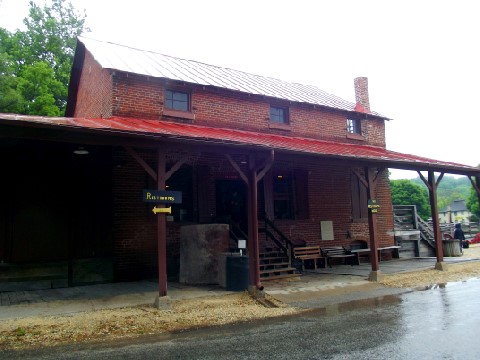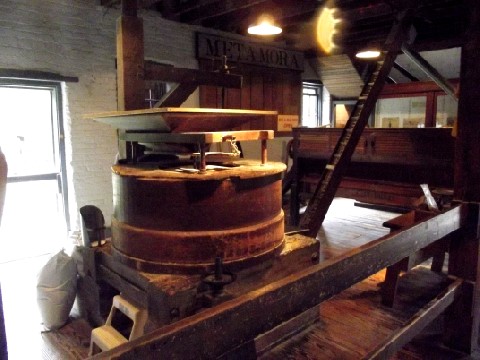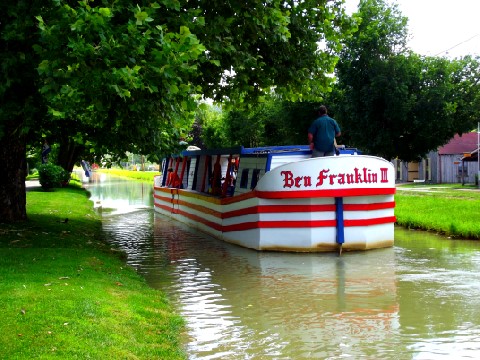Whitewater Canal State Historic Site
Whitewater Canal
Constructed as part of the Indiana Mammoth Internal Improvement Act of 1836 signed by Governor Noah Noble on January 27, 1836, the Whitewater Canal was to form an integral part of southeastern and eastern Indiana's transportation system. The ambitious act, in concert with the Panic of 1837, bankrupted the state and brought a major political party to its knees.
Indiana Mammoth Internal Improvement Act of 1836
The Internal Improvement Act was a too ambitious program of internal improvements that provided for the construction of canals and turnpikes. The ambitiousness of the program bankrupted the State of Indiana and caused the eventual demise and collapse of the Whig party, which favored the bill. The state assembly passed the bill that added ten million dollars to the state's budget at a time when its income was only about $65,000 annually.
Panic of 1837
This complex event created an economic depression that lasted from about 1837 until 1842. The multiple causes were questionable lending practices in the Western United States, restrictive lending policies enacted by Great Britain and falling agricultural prices. The period before 1837 had been a period of intense economic growth. During this time the prices of cotton and other commodities rose. Land prices also increased. The Bank of England noticed a decline in cash on hand in 1836. They raised interest rates in an attempt to attract more cash. When the Bank of England raised its interest, it forced banks in the United States and other nations to raise their rates. This, along with other events, caused land and cotton prices to fall. The chain of events this set off triggered a depression that caused profits, prices, and wages to fall and increased the unemployment rates. It was not until 1843 that the economies of the major countries rebounded.
Decline of the Whigs
The Whig party had pushed for the law and consequently bore the brunt of the blame. During the following years, the Whig Party collapsed, leaving the Democratic Party in control for many years.
Whitewater Canal
The Whitewater Canal's construction lasted from 1836 to 1847. During this time, there were many starts, pauses as the State of Indiana ran out of money, and the various private companies charged with completing also ran into financial difficulties. After completion, it connected Hagerstown, Indiana with Cincinnati, Ohio seventy-six miles to the south. The canal provided a quick, convenient way for farmers to transport their goods to market in the cities. Before the canal a farmer would need several days travel over deeply rutted roads to take his goods to Cincinnati. The canal proved a difficult construction project. It dropped 491 feet over the distance and needed fifty-six locks and seven dams. Several aqueducts to carry the canal over waterways also needed construction. Portions of the canal operated until 1862. The Whitewater Valley Railroad runs a part of the canal as a tourist attraction between Connersville and Metamora Indiana. The train runs alongside the canal and at Metamora visitors can ride a canal boat. The town of Metamora has many small shops and museums. The Indiana State Museum maintains an operating gristmill in the town as part of its network of Indiana State Historic Sites.
The Gristmill
Build by Jonathan Banes in 1845, the mill has used the current of the Whitewater Canal as a power source ever since.
Brief History by the Author
Jonathan Banes (February 12, 1817 - April 13, 1906)
The son of Jonathan and Anna (Gillingham) Banes, Jonathan was native to Buck's County, Pennsylvania. He apprenticed to a carpenter in Montgomery County, Pennsylvania after leaving home at age sixteen. After completing his apprenticeship, he worked in Philadelphia for a time, and then migrated to Brookville in 1837 when he heard the news of the construction of the Whitewater Canal. He gained employment doing construction on the canal project, becoming the supervisor of many of the structures on the canal. These projects included the Brookville dam, several of the locks and bridges on the canal. Banes Married Maria Mount, the daughter of Judge David Mount, on September 5, 1841. The couple would have two sons, William Mount and Mary. The state suspended work on the canal in the fall of 1839. Banes did not receive payment until spring, 1840. He took the funds, purchased some horses and drove them to Pennsylvania to sell. After completing the sale, he returned to Brookville. He moved to Metamora open the Metamora Cotton Factory in 1845. He built his home in Metamora the same year he built the mill. The house, the Banes Home, houses a gift shop and the "Banes Suite for Two," which visitors may rent during a stay in Metamora. Banes would convert the cotton mill to a gristmill in 1856. After selling the mill, Banes became a farmer and land investor. He is interred with his wife in Metamora Cemetery, Metamora.
Metamora Cotton Factory
Equipped with 1000 spindles to spin raw cotton into thread, the three-story mill opened in 1845. Bane had to import the cotton from the south because it is not grown in Indiana. The canal made it less expensive to import cotton cloth and ready-made clothing, thus the mill became unprofitable. Bane removed the cotton making machinery and installed equipment to grind grains into flour and meal. Several cotton mills operated in the state of Indiana during this period, using the power of water to spin raw cotton or wool into thread. Known variously as the Hoosier Mills and Crescent Mill, a fire destroyed the building in 1899. The mill was rebuilt, but fire destroyed that building in 1932. The current two-story building was built the same year.
Whitewater Canal State Historic Site
Open from April through November, the Whitewater Canal State Historic Site is free. Visitors may purchase mill products inside the gristmill, watch the mill wheel turn or ride the canal boat, Ben Franklin. Special rates are available for schoolchildren. Groups may rent the facility for special occasions.The Indiana State Museum currently operates the mill, grinding corn into meal that visitors may purchase as they watch the waterwheel use the canal's energy to turn the immense grist wheels. Visitors to the mill may also purchase tickets to ride the canal boat, the Ben Franklin. Check the web site or call the phone number listed below for events, hours, admission prices and other information.
Whitewater Canal State Historic Site
19083 Clayborne St.
Metamora, In 47030,
765-647-6512
Whitewater Valley Railroad
The demise of the Whitewater Canal planted the seeds for the Whitewater Valley Railroad in the mid 1850's when floods washed out large portions of the canals. Franklin County residents petitioned the State of Indiana, asking that the state sell the canal towpath route to use as a railroad. In 1863 the Indianapolis and Cincinnati Railroad purchased the rights to the towpath and built a line from Brookville to Hagerstown, Indiana. Portions of the canal remained open and became useful as power sources for gristmills like the one at Metamora. The Whitewater Canal remained open in Metamora until 1953. Western Avenue now covers it.
The First Whitewater Valley Railroad
The first Whitewater Valley Railroad was a subsidiary of the Indianapolis and Cincinnati Railroad. This subsidiary began construction of the rail line from Brookville, reaching Connersville in 1867. The line punched through to Hagerstown the next year. The Big Four, Cleveland, Cincinnati, Chicago & St. Louis, Railroad purchased the Indianapolis and Cincinnati Railroad in 1890. This line became the New York Central in later years. These lines operated both freight and passenger trains. The line discontinued passenger service in 1933. Freight service ground to a halt in the late 1970's and early 1980's.
The Second Whitewater Valley Railroad
Formed as a non-profit organization in 1972, the Whitewater Valley Railroad operates as a operating railroad museum. The all volunteer staff runs both historic diesel and steam engines on the eighteen mile line between Connersville and Metamora. For more information about train schedules, the history and other information, contact:
Whitewater Valley Railroad
455 Market St,
Connersville, IN 47331
(765) 825-2054
 |
| Whitewater Canal State Historic Site |
Constructed as part of the Indiana Mammoth Internal Improvement Act of 1836 signed by Governor Noah Noble on January 27, 1836, the Whitewater Canal was to form an integral part of southeastern and eastern Indiana's transportation system. The ambitious act, in concert with the Panic of 1837, bankrupted the state and brought a major political party to its knees.
Indiana Mammoth Internal Improvement Act of 1836
The Internal Improvement Act was a too ambitious program of internal improvements that provided for the construction of canals and turnpikes. The ambitiousness of the program bankrupted the State of Indiana and caused the eventual demise and collapse of the Whig party, which favored the bill. The state assembly passed the bill that added ten million dollars to the state's budget at a time when its income was only about $65,000 annually.
Panic of 1837
 |
| Exploring Indiana's Historic Sites, Markers & Museums - South East Edition |
Decline of the Whigs
The Whig party had pushed for the law and consequently bore the brunt of the blame. During the following years, the Whig Party collapsed, leaving the Democratic Party in control for many years.
Whitewater Canal
The Whitewater Canal's construction lasted from 1836 to 1847. During this time, there were many starts, pauses as the State of Indiana ran out of money, and the various private companies charged with completing also ran into financial difficulties. After completion, it connected Hagerstown, Indiana with Cincinnati, Ohio seventy-six miles to the south. The canal provided a quick, convenient way for farmers to transport their goods to market in the cities. Before the canal a farmer would need several days travel over deeply rutted roads to take his goods to Cincinnati. The canal proved a difficult construction project. It dropped 491 feet over the distance and needed fifty-six locks and seven dams. Several aqueducts to carry the canal over waterways also needed construction. Portions of the canal operated until 1862. The Whitewater Valley Railroad runs a part of the canal as a tourist attraction between Connersville and Metamora Indiana. The train runs alongside the canal and at Metamora visitors can ride a canal boat. The town of Metamora has many small shops and museums. The Indiana State Museum maintains an operating gristmill in the town as part of its network of Indiana State Historic Sites.
The Gristmill
 |
| Whitewater Canal State Historic Site - Gristmill |
Build by Jonathan Banes in 1845, the mill has used the current of the Whitewater Canal as a power source ever since.
Brief History by the Author
Jonathan Banes (February 12, 1817 - April 13, 1906)
The son of Jonathan and Anna (Gillingham) Banes, Jonathan was native to Buck's County, Pennsylvania. He apprenticed to a carpenter in Montgomery County, Pennsylvania after leaving home at age sixteen. After completing his apprenticeship, he worked in Philadelphia for a time, and then migrated to Brookville in 1837 when he heard the news of the construction of the Whitewater Canal. He gained employment doing construction on the canal project, becoming the supervisor of many of the structures on the canal. These projects included the Brookville dam, several of the locks and bridges on the canal. Banes Married Maria Mount, the daughter of Judge David Mount, on September 5, 1841. The couple would have two sons, William Mount and Mary. The state suspended work on the canal in the fall of 1839. Banes did not receive payment until spring, 1840. He took the funds, purchased some horses and drove them to Pennsylvania to sell. After completing the sale, he returned to Brookville. He moved to Metamora open the Metamora Cotton Factory in 1845. He built his home in Metamora the same year he built the mill. The house, the Banes Home, houses a gift shop and the "Banes Suite for Two," which visitors may rent during a stay in Metamora. Banes would convert the cotton mill to a gristmill in 1856. After selling the mill, Banes became a farmer and land investor. He is interred with his wife in Metamora Cemetery, Metamora.
Metamora Cotton Factory
Equipped with 1000 spindles to spin raw cotton into thread, the three-story mill opened in 1845. Bane had to import the cotton from the south because it is not grown in Indiana. The canal made it less expensive to import cotton cloth and ready-made clothing, thus the mill became unprofitable. Bane removed the cotton making machinery and installed equipment to grind grains into flour and meal. Several cotton mills operated in the state of Indiana during this period, using the power of water to spin raw cotton or wool into thread. Known variously as the Hoosier Mills and Crescent Mill, a fire destroyed the building in 1899. The mill was rebuilt, but fire destroyed that building in 1932. The current two-story building was built the same year.
Whitewater Canal State Historic Site
 |
| Whitewater Canal - Ben Franklin Canal Boat |
Whitewater Canal State Historic Site
19083 Clayborne St.
Metamora, In 47030,
765-647-6512
Whitewater Valley Railroad
 |
| Whitewater Valley Railroad |
The demise of the Whitewater Canal planted the seeds for the Whitewater Valley Railroad in the mid 1850's when floods washed out large portions of the canals. Franklin County residents petitioned the State of Indiana, asking that the state sell the canal towpath route to use as a railroad. In 1863 the Indianapolis and Cincinnati Railroad purchased the rights to the towpath and built a line from Brookville to Hagerstown, Indiana. Portions of the canal remained open and became useful as power sources for gristmills like the one at Metamora. The Whitewater Canal remained open in Metamora until 1953. Western Avenue now covers it.
The First Whitewater Valley Railroad
The first Whitewater Valley Railroad was a subsidiary of the Indianapolis and Cincinnati Railroad. This subsidiary began construction of the rail line from Brookville, reaching Connersville in 1867. The line punched through to Hagerstown the next year. The Big Four, Cleveland, Cincinnati, Chicago & St. Louis, Railroad purchased the Indianapolis and Cincinnati Railroad in 1890. This line became the New York Central in later years. These lines operated both freight and passenger trains. The line discontinued passenger service in 1933. Freight service ground to a halt in the late 1970's and early 1980's.
The Second Whitewater Valley Railroad
Formed as a non-profit organization in 1972, the Whitewater Valley Railroad operates as a operating railroad museum. The all volunteer staff runs both historic diesel and steam engines on the eighteen mile line between Connersville and Metamora. For more information about train schedules, the history and other information, contact:
Whitewater Valley Railroad
455 Market St,
Connersville, IN 47331
(765) 825-2054
Comments
Post a Comment